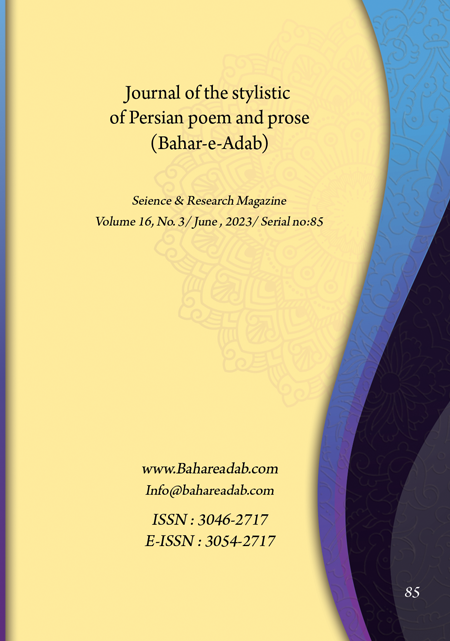- Count View : 381
- آدرس کوتاه شده مقاله: https://bahareadab.com/article_id/1465
- کد doi مقاله: Doi: 10.22034/bahareadab.2023 .16 .6755
Journal of the stylistic of Persian poem and prose
volume Number 16،
number In Volume 3،
،
issue Number 85
Molavi’s Ontological Approach to the World of Imagination in the First Book of Masnavi
Shadi Ebrahimkhani , Mohammad Hossein Bayat (Author in Charge), Esmaeil Tajbakhsh , Batul Vaez
Abstract
BACKGROUND AND OBJECTIVES: The viewpoints related to the imaginary world are based on two approaches: ontology and epistemology. The ontological approach considers the world of imagination as one of the levels of existence, which is the boundary between the world of minds and the world of matter; On the other hand, the epistemological approach considers imagination as one of the powers of human perception, which is limited to imagination. Among the mystics who have addressed this issue is Rumi, who has made indirect references to this world in his Masnavi, but unlike great scholars such as Mulla Sadra, Sheikh Ashraq, and Ibn Arabi, there is no independent chapter called the world of imagination in his works. For this reason, some think that in the Masnavi, the subject of the imaginary world is not raised as a level of existence, and the meaning of the imaginary world in the Masnavi is simply the connected imagination, imagination and mental imagination. Most of the researches that have discussed about imagination in Masnavi have examined imagination only in the field of epistemology and have considered it as one of the perceptive powers of humans, which mostly has a negative aspect and hinders the achievement of knowledge. The main goal of this research is based on the fact that the imaginary world in the Masnavi includes ontology, epistemology or both fields.
METHODOLOGY: In this research, with a descriptive-analytical method, the ontology of the imaginary world as one of the levels of being and being in Molavi"s thought has been proven by relying on the first book of the Masnavi.
FINDINGS: In Rumi"s opinion, imagination is not only one of the inner powers of man, but it is also accepted as a level of existence and has been conceptually discussed in many Masnavi verses.
CONCLUSION: Molavi considers the ways to reach the world of fantasy to be things such as the transformation of external attributes into internal ones, sleep and dreams, inspiration, natural death and voluntary death.
Keyword
World of Imagination
, Contiguous Imagination
, Discontinuous Imagination
, Ontology
, Epistemology
, Molavi Rumi
, Masnavi.
- Ghoran, Translator: Hussein Ansarian, Qom: Aeen-e-Danesh.
- Alyari, Shamsi. (2016). “Examining the meanings and examples of Imagination in Molavi`s Masnavi”, Studies of literature, mysticism and philosophy,the second period, Number 1/3, pp. 617 - 623.
- Angharavi, Rosukh-al-din, Esmail. (1995). Great Description of Angharavi to Masnavi Manavi, 13-volume book, Translator: Sattarzadeh, Esmat, Tehran: Zarrin.
- Articels:
- Aryan, Hussein and Kamali Banyani, Mahdi Reza. (2016). “An Analysis of dreams and mystical dreams from the perspective of Molana in Masnavi Manavi” Islamic Mystic, Number 50, pp. 213 – 233.
- Ashtiani, Seyed Jalal-e-din. (1996). Description of Qaysari`s introduction to Fosus-al-Hekam, Qom: Publication Center of Islamic Advertising Office of Hozeye Elmiyeye Qom.
- Bayat, MohammadHussein. (1995). The basic of Mysticism and Sufism, Tehran: Allameh Tabatabayi University.
- Borghe’i, Zohreh. (2010). The mind of Ebn-e-Sina and Sadr-al-Moteallehin about Imagination (Khial), Ghom: Boostan-e-Ketab.
- Chitic, Wiliam. (2015). Imagination World (Ibn-e-Arabi and the Problem religious differences), Translator: Kakayi, Ghasem, Tehrsn: Hermes.
- Davari Ardakani, Reza. (2002). “A comment on the World of Imagination”, Kheradnameh Sadra, Number28, pp.19-21.
- Ebn-e-Arabi, Mohammad ibn Ali. (2001). Tafsire Ebn-e-Arabi, two-volume book, author: Samir Mostafa, Beirut: Dar Ehya Al-toras Al-arabi.
- Ebn-e-Arabi, Mohammad ibn Ali. (2013). Fosus-al-Hekam, Explain by: Movahhed, MohammadAli and Movahhed, Samad, Tehran: Karnameh.
- Forouzanfar, Badi-al-zaman. (2007). Discription of Masnavi Sharif, three-volume book, Tehran: Zavvar.
- Gheysari, Davood. (2008). Gheysari`s Description to Fosous-al-hekam of Ebn-e-Arabi, two-volume book, Translator: Khajavi, Mohammad, Tehran: Mola
- Kharazmi, Kamal-al-din Hussein-ibn-Hasan. (2005). Javaher-al-Asrar and Zavaher-al-Anvar (Discription of Masnavi Manavi),4-volume book, Introduction and Correction by: Shariat, Mohammad Javad, Tehran: Asatir.
- Molavi, Jalal-al-din. (1998). Masnavi Manvi, according to the corrected version of Nikelson, Trying by: Azaryazdi (Khoramshahi), Mahdi, Tehran: Pazhouhesh.
- Nikelson, Rinold Elin. (1995). Discription of Molavi`s Masnavi Manavi, Translator: Lahouti, Hasan, Tehran: Scientific and Cultural.
- Sabzevari, Haj Molla Hadi. (1994). Description of Masnavi, Trying by: Borujerdi, Mostafa, Tehran: Ministry of Culture and Islam Gidance, Printing and Publishing Organization.

